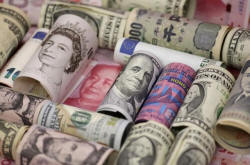|
Dollar index at 4-month
high on strong U.S. data, Fed hike hopes
 Send a link to a friend
Send a link to a friend
 [July 20, 2016]
By Anirban Nag [July 20, 2016]
By Anirban Nag
LONDON (Reuters) - The dollar hit a
four-month high against a basket of currencies on Wednesday,
bolstered by strong U.S. data and growing expectations that the
Federal Reserve may raise rates before the end of the year.
Commerce Department data showed U.S. housing starts surged 4.8
percent, underpinning a theme of strength in the economy.
Fed funds futures rates point to investors seeing around a 40
percent chance the Fed will raise interest rates by its December
meeting, according to CME Group's FedWatch tool, compared with less
than 20 percent a few weeks ago. Expectations of a Fed hike come as
other major central banks around the world gear up to ease monetary
policy.
The dollar index, which tracks the currency against a basket of six
major rivals, hit a peak of 97.323 <.DXY> in European trade, its
highest level since March 10. It was last trading at 97.104, a tad
higher on the day.
The dollar rose 0.5 percent against the yen to 106.715 yen <JPY=>,
its highest level since June 24, when markets were shaken by
Britain's surprise vote to exit the European Union.

"The dollar is now being supported by rising U.S. rate expectations.
The likelihood of a Fed rate hike before the end of the year that is
being priced in by the markets has almost returned to the levels
seen before the EU referendum," said Thu Lan Nguyen, currency
strategist at Commerzbank.
"Most recently the rising rate hike expectations are mainly due to
better economic and inflation developments in the US."
Speculators have also been unwinding their safe-haven bids in the
yen as the initial shocks from the Brexit vote dissipated, and
expectations rose of additional easing from the Bank of Japan at its
July 28-29 meeting.
A majority of economists polled by Reuters expect further BOJ
easing.
Japanese policymakers are unlikely to go as far as funding
government spending through direct debt monetisation, dubbed
"helicopter money", but might pursue a mix of aggressive fiscal and
monetary expansion to battle deflation, according to sources.
[to top of second column] |

Euro, Hong Kong dollar, U.S. dollar, Japanese yen, British pound and
Chinese 100-yuan banknotes are seen in a picture illustration shot
January 21, 2016. REUTERS/Jason Lee/Illustration/File Photo

The dollar's rise saw the euro <EUR=> fall to $1.10980, its lowest since June
27. The European Central Bank will hold a regular policy meeting on Thursday,
its last before an eight-week break. It is not expected to take any additional
easing steps but could take a dovish line given the uncertainty from Brexit.
"The ECB governing council is unlikely to say anything supportive of the
currency at its Thursday meeting," said John Hardy, head of currency strategy at
Saxo Bank.
Meanwhile, sterling outperformed, rising 0.5 percent to $1.3175 <GBP=D4> after a
Bank of England survey showed no clear evidence of a slowing of economic
activity after last month's Brexit vote. [GBP/]
(Editing by Keith Weir and John Stonestreet)
[© 2016 Thomson Reuters. All rights
reserved.] Copyright 2016 Reuters. All rights reserved. This material may not be published,
broadcast, rewritten or redistributed.

 |